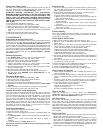
Tee fitting
Refer to pressure relief/expansion
tank schematic above.
OPTION 2
OPTION 1
A bent tube (as shown) is
installed for the hot water
outlet on side outlet water
heaters to ensure a maxi-
mum of hot water supply.
This fitting must be aligned
properly. The 'line' on the
fitting must be oriented
pointing up. When in correct
position, the hot water is
drawn from the highest
point in the tank.
SPACESAVER™ MODELS
(SIDE OUTLET) ONLY
NOTE
TO INSTALLERS:
1. Cold water inlet
2. Hot water outlet
3. Anode(s)
4. Temperature and pressure (T&P) relief valve*
4a. Alternate location of T&P relief valve*
5. Thermostat with High-limit switch
6. Element
7. Access door - not illustrated
8. Thermostat
9. Drain valve
10. Water supply to meter
11. Water supply to water heater
12. Water meter with backflow preventer
13. Overflow
14. Pressure relief valve
15. Expansion tank
16. Pipe Insulation (mandatory if supplied with
heater)
*Items to be supplied by installer.
Options 1 and 2 show the location of pressure relief
and/or expansion tank if a check valve or pressure
reducing valve is in the cold water supply to the
house. Use option 1 or 2 as convenient. If a pressure
relief valve is used (OPTION 1) select one with a set-
ting 25 psi below the relief valve rating used on the
heater.
Also see 'Hot Water Odour' section.
· Asudden appearance of rusty water can indicate the anode rod has been
depleted. The remaining steel core wire may be corroding, releasing
iron particles into the water. Inspect and replace as necessary. Also see
'Cathodic Protection: Anode Maintenance' section.
Water Heater Makes Noise
Sediment, sand or scale can accumulate resulting in "rumbling" or a
"hissing" noise. Water heaters need to be flushed regularly to minimize
buildup. Severe accumulations can cause premature failure of the water
heater elements.
Extended Non Use Service
Caution: Hydrogen gas can be produced in a hot water system served
by this heater that has not been used for a long period of time (generally
two (2) weeks or more). Hydrogen gas is extremely flammable and can
ignite when exposed to a spark or flame. To reduce the risk of injury
under these conditions, it is recommended that the hot water faucet be
opened for several minutes at the kitchen sink before using any electrical
appliance connected to the hot water system. Use caution in opening
faucets. When hydrogen is present, there will probably be an unusual
sound such as air escaping through the pipe as the water begins to flow.
There should be no smoking or open flame near the faucet at the time it
is open.
Pressure Build-Up (Thermal Expansion)
During the heating cycle of the water heater, the water expands creating
a pressure build-up in the plumbing system. If the pressure exceeds 150
PSI, water will come out of the valve. This is a normal safety function of
the T&P valve. The water supply meter may have a check valve or back
flow preventer inside. This can increase the possibility of pressure build-
up. Causes of discharge can be thermal expansion, excess system pres-
sure, too high a temperature setting on the thermostat or something in the
water heater causing excess temperatures in the heater.
Thermal Expansion: When water is heated it expands. For example, in
a 40-gallon water heater, water being heated to its thermostat setting will
end up expanding by approximately 1/2 gallon. This extra volume creat-
ed by the expansion has to go somewhere or pressure will dramatically
increase, such as when water is heated in a closed system. A good indi-
cation of thermal expansion is when the T&P valve releases about one
cup of water for every 10 gallons of heater capacity with each heating
cycle. The T&P valve is functioning properly when it relieves pressure
caused by thermal expansion, but frequent relief can result in a build up
of natural mineral deposits on the valve seat, rendering the valve inoper-
ative. Should this happen, the T&P valve needs to be replaced. To prevent
this 'T & P VALVE' from discharging hot water, the loss of energy and
reduce the possible build-up of lime in the 'T & P VALVE' there are two
(2) recommendations:
OPTION 1: Install a 125 PSI Pressure Relief (only) valve in the cold
water supply line. Make sure that the discharge of this valve is directed
to a drain to prevent water damage and it is protected from freezing,
OR
OPTION 2: Install an expansion tank on the cold water supply line. For
every 50 U.S. gallons of stored water, the expansion tank must have a
minimum capacity of 1.5 U.S. gallons.
Temperature Relief: The T&P valve will discharge varying amounts of
water, but typically more than you would experience from thermal expan-
sion. Check the temperature in relation to the setting on the thermostat
dial. A malfunctioning thermostat could cause the water to get too hot.
5
Drain pan*
Floor drain
Floor Drain
Drain pan*
Floor drain
Drain valve*
Cold in
Hot out
Cold in
Hot out








